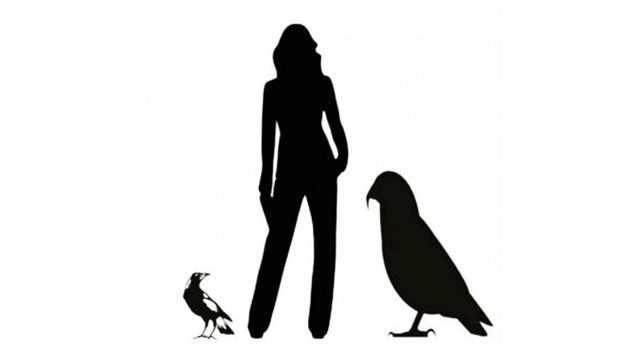
 Graphic showing the Heracles inexpectatus silhouette next to an average height woman and common magpie. (Canterbury Museum)(NEW YORK) — The fossils of a parrot that was the size of a small child and with an appetite so voracious it may have eaten other parrots have been discovered.
Graphic showing the Heracles inexpectatus silhouette next to an average height woman and common magpie. (Canterbury Museum)(NEW YORK) — The fossils of a parrot that was the size of a small child and with an appetite so voracious it may have eaten other parrots have been discovered.
The bird, named Heracles inexpectatus, stood at 3 feet tall and weighed around 15.4 pounds when it roamed the Earth some 19 million years ago, according to a new study published Tuesday in the journal Biology Letters.
It is believed to be the world’s largest parrot.
Its fossils were found near the town of St Bathans in Central Otago, New Zealand, in an area known for its diverse collection of fossil birds.
“New Zealand is well known for its giant birds. Not only moa dominated avifaunas, but giant geese and adzebills shared the forest floor, while a giant eagle ruled the skies,” Trevor Worthy, co-author of the study and a professor at Australia’s Flinders University, said in a statement.
“But until now, no one has ever found an extinct giant parrot – anywhere,” he said.
Due to its size, paleontologists believe it would have had a “massive parrot beak that could crack open anything it fancied” and “may well have dined on more than conventional parrot foods, perhaps even other parrots.”
The Heracles is twice the size of the critically endangered flightless New Zealand kakapo, previously the largest known parrot. It is comparable in size to a giant “dogo” pigeon from the Mascarenes Islands.
The parrot was most likely part of an ancient group of parrots in New Zealand that did not survive the affect climate cooling had on subtropical forests and vegetation, according to a press release from Flinders University on the discovery.
The fossils of the animal showed that it lived in a diverse fauna with crocodiles, turtles, bats, other mammals and over 40 bird species.
Researchers noted they have been excavating fossils for 20 years and more surprising discoveries are likely.
“While Heracles is one of the most spectacular birds we have found, no doubt there are many more unexpected species yet to be discovered in this most interesting deposit,” Worthy said.
Copyright © 2019, ABC Radio. All rights reserved.
